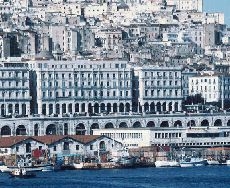
Guide of Algeria
by Salima Delhoum
ALGERIA is a mediterranean country located between Morocco and Tunisia. It is often called the door of Africa and with its more than 2.3 million square kilometers, it is the second largest country of the continent after Sudan. The country offers a wide variety of landscapes: sandy beaches in the North with almost a thousand kilometers of coast, a quite large desert known as "The Sahara" and in between high plateaus and hills which are called the "Tellian Atlas". There are also some mountains scattered in the northern part of the country. The climate of the North is mild with wet winters and hot and dry summers. The tellian Atlas is drier with rigorous winters while the South has sand/dust winds where it is hot in the day time and cold by night.
The population is mostly young since over seventy percent of the population is less than thirty years old. Arabic is the mother tongue and Islam is the religion followed by Algerian men and women. The country enjoys a blend of cultural styles which are recognized through the traditional savorous cuisine, ornamental clothing and jewellery to name a few.
The first stop for anyone visiting the country would be undoubtedly its capital city Algiers. Today it is a major city with all modern commodities. It overlooks the bay with its legendary old city known as the "Casbah". The Casbah forms the upper part of the city and has narrow passageways and a 16th century walled fortress

View of Algiers from the port
Algiers had its part of history through the myriad of conquestors end invadors who tried to settle down. The city witnesses the passage of the Spanish, Ottomans, French and before them the Romans and the Vandals.
The city originally called Al Jaza'ir was established by the ruler Bologhine Ibn Ziri about AD 950 and soon became an important trading center.

Aerial views of Algiers
Southern cities such as Djanet, Ghardaia, Timimoun, Tammanrasset, etc. are quite appreciated for their unique and exotic landscapes: memorable sunsets, and golden sand and dunes in an endless Sahara desert.

Oasis in TIMIMOUN
The Sahara as a whole is a tableland with an average elevation of 1300 to 1600 feet, with small patches of elevation as depressed as 500 feet. Notable peaks are the Tahat (9852 ft). Sprinkled amid the sand and rock are oases in which native people, date palms and acacias flourish.

Dunes of TAMMANRASSET
Algeria is an independent country since July 5th, 1962. Each year it celebrates the 1st of November which represents the day of upraisal against the colonial army that was a certain 1st of November 1954. Independence would not have been possible without the sacrifice of millions of Algerian men and women who have suffered in the cities and especially the villages, rural areas, mountains and the South. The more isolated they were the more they suffered. The most terrific warfare had been used against civil populations. Today the dead are remembered and honored.
Today, the country is recovering after a long troubled period that lasted for almost a decade. The recovery has been possible thanks to the strength and solidarity of its people. Today the country is turned to the rest of the world which it wants to be an effective part of.